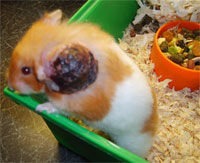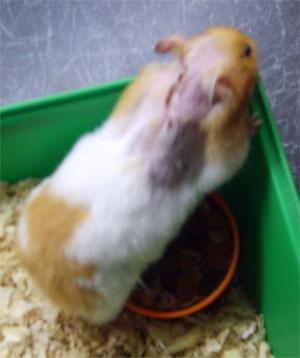| |
Abscess in a hamster

A hamster with an encapsulated abscess. This was successfully removed |

After the removal of the abscess |
A hamster with an abscess: An abscess is a localized collection of pus that can develop or form in any part of the body and is normally surrounded by a swelling. Abscesses are caused by minor breaks or punctures in the skin that let infectious organisms, parasites, or foreign substances enter the wound.
Abscesses on the surface of the skin are easily noticeable by the swelling, but in other areas of the body they may not be so obvious. Internal abscesses may cause significant organ damage.
The primary treatment of an abscess is for a veterinarian to drain them. However, it is important never to attempt to drain the abscess yourself, as this can lead to trauma of the surrounding tissue that may help to spread the underlying infection, although sometimes an abscess may open and drain spontaneously, appropriate antibiotics will be needed.
One of the most common sites for an abscess to develop on a hamster is the sebaceous glands, particularly more so on the Dwarf hamster as the glands can sometimes become blocked and then become infected by the secretions from the gland itself.

A hamster with an abscess
The hamster in the video footage above has a very large growth just behind her ear; it was found to be an encapsulated abscess. An encapsulated abscess is one in which the body has made an unsuccessful attempt at trying to heal the wound. In the process of doing so it has in effect walled off or isolated the infection from the rest of the body. The fibroblasts (Fibroblasts are the primary type of cell found in the dermis of skin) make it to the periphery of the lesion and begin laying down fibrin at its edges. This can be interpreted as an attempt by the body to prevent the spread of the infection, or the body has attempted to heal the wound before it had time to clear the infection. In either case, the fibroblasts essentially wall off the site of infection and impede migration of neutrophils to the site.
.

The abscess was successfully surgically removed.

3 week later the wound has healed well, and fur is starting to grown again.
|
|


